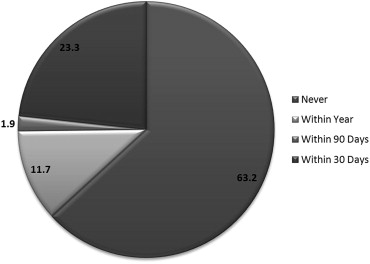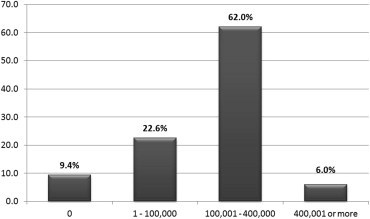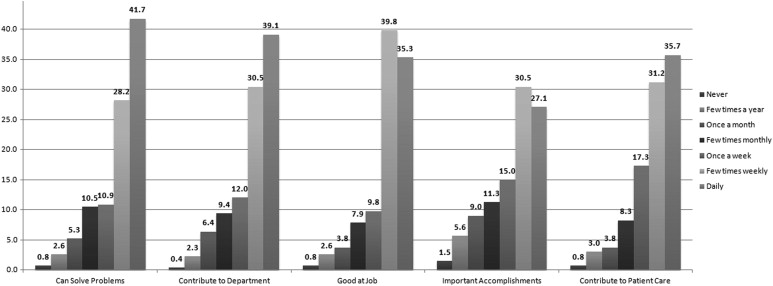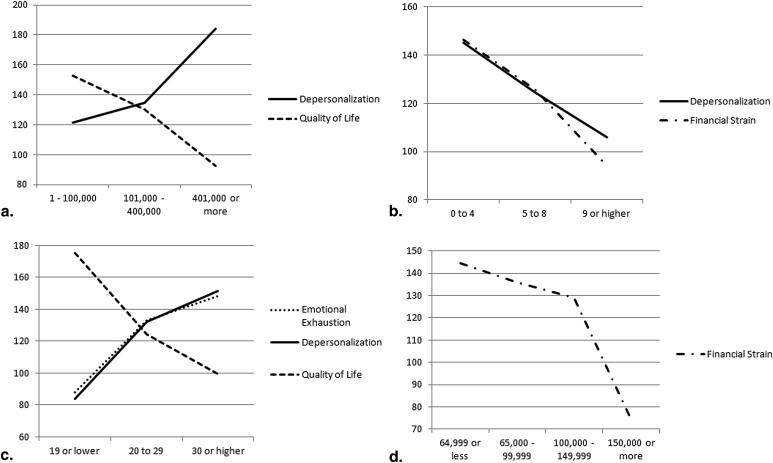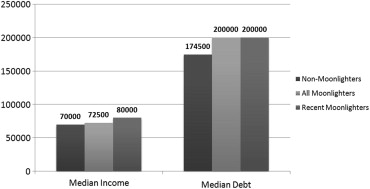Rationale and Objectives
Burnout is a complex phenomenon characterized by emotional exhaustion, social detachment, and feelings of low personal achievement. In this study, we aim to establish the prevalence of burnout among radiology trainees and to explore the factors influencing its development.
Materials and Methods
Survey data were collected from 266 trainee members of the Association of University Radiologists to assess financial status, attitudes toward money and compensation, and burnout symptomology. Descriptive and inferential statistics were used to analyze these data.
Results
Most radiology residents reported high levels of personal achievement but routine symptoms of emotional exhaustion and depersonalization. Although increasing levels of household debt were correlated with symptoms of depersonalization and lower reported quality of life, we found that the subjective financial experience was a more reliable indicator of emotional well-being. Specifically, higher subjective self-assessments of financial strain were the best predictors of symptoms of depersonalization ( P < .0001), emotional exhaustion ( P < .0001), and lower self-reported quality of life ( P < .0001). Additionally, residents with recent moonlighting activity reported higher levels of personal achievement ( P < .05), lower levels of emotional exhaustion ( P < .05), and greater quality of life ( P < .05) when compared to non-moonlighters.
Conclusions
The unique nature of radiology training could mean that traditional assumptions regarding the development of trainee burnout do not necessarily apply. Finances may be an underappreciated influence on resident burnout, and subjective feelings of financial scarcity could outweigh the impact of objective indebtedness. Further study is needed to ensure that the emotional well-being of radiology trainees is optimally supported.
Burnout is a psychological syndrome, arising in response to prolonged occupational stress, which is characterized by emotional depletion, pathologic detachment, and feelings of personal inadequacy. The negative impact of work-related stress on resident physicians and their performance in the clinical setting is well established , but currently there are no studies examining the prevalence of burnout symptoms among radiology residents . Financial instability has been shown to be a principal stressor for resident physicians . However, there remains a paucity of evidence regarding the specific influence of financial strain on burnout among medical trainees . The purpose of this study is to explore the prevalence of burnout symptoms among radiologists in training and to explore the factors influencing its development.
Methods
This investigation was exempted from full review by the University of Washington institutional review board. In January 2012, an electronic survey was distributed to all resident and fellow junior members of the Association of University Radiologists with registered e-mail addresses (1389 members). The survey questions are reproduced in the Appendix . A 4-week reminder e-mail was sent and responses gathered for a total of 8 weeks.
Get Radiology Tree app to read full this article<
Get Radiology Tree app to read full this article<
Get Radiology Tree app to read full this article<
Get Radiology Tree app to read full this article<
Results
Survey Sample Demographics
Get Radiology Tree app to read full this article<
Household Finances
Get Radiology Tree app to read full this article<
Get Radiology Tree app to read full this article<
Residency-Related Finances
Get Radiology Tree app to read full this article<
Table 1
Resident Perceptions of Work-related Departmental Subsidies
Benefit No Subsidy ∗ Inadequate Subsidy Adequate Subsidy Full Subsidy Books, educational materials 38 (14) 130 (49) 81 (30) 17 (6) Medical license, DEA certification 143 (54) 39 (15) 21 (8) 63 (24) ABR dues/fees 152 (57) 45 (17) 24 (9) 45 (17) AIRP expenses 14 (5) 136 (51) 69 (26) 47 (18)
ABR, American Board of Radiology; AIRP, American Institute for Radiologic Pathology; DEA, Drug Enforcement Administration.
Get Radiology Tree app to read full this article<
Get Radiology Tree app to read full this article<
Perceived Financial Strain
Get Radiology Tree app to read full this article<
Table 2
Resident Responses to Questions Regarding Financial Strain
Statement Strongly Disagree ∗ Disagree Somewhat Disagree Neutral Somewhat Agree Agree Strongly Agree My current financial situation is a serious strain. 21 (7.9) 34 (12.8) 25 (9.4) 39 (14.7) 49 (18.4) 58 (21.8) 40 (15.0) I often think about my current financial situation. 12 (4.5) 15 (5.6) 8 (3.0) 16 (6.0) 45 (16.9) 74 (27.8) 96 (36.1) Due to my financial situation, I have difficulties paying for mandatory work-related expenses (eg, American Board of Radiology dues, licensing) 37 (13.9) 49 (18.4) 28 (10.5) 40 (15.0) 42 (15.8) 38 (14.3) 32 (12.0) Due to my financial situation, I have difficulties purchasing optional work-related expenses (eg, textbooks) 26 (9.8) 51 (19.2) 20 (7.5) 30 (11.3) 48 (18.0) 43 (16.2) 48 (18.0) Due to my financial situation, I have difficulties paying for my apartment and utilities. 44 (16.5) 74 (27.8) 40 (15.0) 41 (15.4) 31 (11.7) 16 (6.0) 20 (7.5) Due to my financial situation, I am restricted in my leisure activities. 17 (6.4) 24 (9.0) 20 (7.5) 21 (7.9) 53 (19.9) 51 (19.2) 80 (30.1)
Get Radiology Tree app to read full this article<
Get Radiology Tree app to read full this article<
Burnout Symptoms in Radiology Trainees
Get Radiology Tree app to read full this article<
Get Radiology Tree app to read full this article<
Get Radiology Tree app to read full this article<
Burnout Symptoms and Financial Strain
Get Radiology Tree app to read full this article<
Get Radiology Tree app to read full this article<
Get Radiology Tree app to read full this article<
Get Radiology Tree app to read full this article<
Get Radiology Tree app to read full this article<
Get Radiology Tree app to read full this article<
Get Radiology Tree app to read full this article<
Comparison of Burnout Prevalence among Radiology Trainees versus Internal Medicine Residents
Get Radiology Tree app to read full this article<
Table 3
Comparison of Burnout Symptoms and Quality of Life between Radiology Trainees and Internal Medicine Residents
Wellness Factor Trainee Responses Emotional exhaustion (EE) High ∗ Low Radiology 142 (53) 124 (47) Internal medicine 7394 (46) 8760 (54) Depersonalization (DP) High Low Radiology 131 (49) 135 (51) Internal medicine 4541 (29) 11,196 (71) High EE or DP Yes No Radiology 165 (62) 101 (38) Internal medicine 8343 (52) 7849 (48) Quality of life Low Not low Radiology 30 (11) 236 (89) Internal medicine 2402 (15) 13,785 (85)
Get Radiology Tree app to read full this article<
Get Radiology Tree app to read full this article<
Discussion
Get Radiology Tree app to read full this article<
Get Radiology Tree app to read full this article<
Get Radiology Tree app to read full this article<
Get Radiology Tree app to read full this article<
Get Radiology Tree app to read full this article<
Get Radiology Tree app to read full this article<
Get Radiology Tree app to read full this article<
Get Radiology Tree app to read full this article<
Get Radiology Tree app to read full this article<
Get Radiology Tree app to read full this article<
Get Radiology Tree app to read full this article<
Conclusions
Get Radiology Tree app to read full this article<
Get Radiology Tree app to read full this article<
Get Radiology Tree app to read full this article<
Appendix
Get Radiology Tree app to read full this article<
Get Radiology Tree app to read full this article<
Get Radiology Tree app to read full this article<
Get Radiology Tree app to read full this article<
Get Radiology Tree app to read full this article<
Get Radiology Tree app to read full this article<
Get Radiology Tree app to read full this article<
Get Radiology Tree app to read full this article<
Get Radiology Tree app to read full this article<
Get Radiology Tree app to read full this article<
Get Radiology Tree app to read full this article<
References
1. Castelo-Branco C., Figueras F., Eixarch E., et. al.: Stress symptoms and burnout in obstetric and gynaecology residents. BJOG 2007; 114: pp. 94-98.
2. Gopal R., Glasheen J.J., Miyoshi T.J., et. al.: Burnout and internal medicine resident work-hour restrictions. Arch Intern Med 2005; 165: pp. 2595-2600.
3. Martini S., Arfken C.L., Churchill A., et. al.: Burnout comparison among residents in different medical specialties. Acad Psychiatry 2004; 28: pp. 240-242.
4. Golub J.S., Weiss P.S., Ramesh A.K., et. al.: Burnout in residents of otolaryngology-head and neck surgery: a national inquiry into the health of residency training. Acad Med 2007; 82: pp. 596-601.
5. Shanafelt T.D., Bradley K.A., Wipf J.E., et. al.: Burnout and self-reported patient care in an internal medicine residency program. Ann Intern Med 2002; 136: pp. 358-367.
6. Thomas N.K.: Resident burnout. JAMA 2004; 292: pp. 2880-2889.
7. Moreno M.A.: Resident stress revisited: a senior pediatric resident’s point of view. Pediatrics 2003; 112: pp. 411-414. discussion 414–415
8. Ratanawongsa N., Wright S.M., Carrese J.A.: Well-being in residency: a time for temporary imbalance?. Med Educ 2007; 41: pp. 273-280.
9. Maslach C., Jackson S.E., Leiter M.P.: Maslach Burnout Inventory Manual.3rd ed.1996.CPP, Inc.Palo Alto, CA
10. Campbell D.A., Sonnad S.S., Eckhauser F.E., et. al.: Burnout among American surgeons. Surgery 2001; 130: pp. 696-702. discussion 702–695
11. Ishak W.W., Lederer S., Mandili C., et. al.: Burnout during residency training: a literature review. J Grad Med Educ 2009; 1: pp. 236-242.
12. Archer L.R., Keever R.R., Gordon R.A., et. al.: The relationship between residents’ characteristics, their stress experiences, and their psychosocial adjustment at one medical school. Acad Med 1991; 66: pp. 301-303.
13. Collier V.U., McCue J.D., Markus A., et. al.: Stress in medical residency: status quo after a decade of reform?. Ann Intern Med 2002; 136: pp. 384-390.
14. Selenko E., Batinic B.: Beyond debt. A moderator analysis of the relationship between perceived financial strain and mental health. Soc Sci Med 2011; 73: pp. 1725-1732.
15. WB S.: Burnout.J F.-C.R P.Stress in Health Professionals: Psychological and Organizational Causes and Interventions.1999.WileyChichester, NY:
16. Rafferty J.P., Lemkau J.P., Purdy R.R., et. al.: Validity of the Maslach Burnout Inventory for family practice physicians. J Clin Psychol 1986; 42: pp. 488-492.
17. West C.P., Dyrbye L.N., Sloan J.A., et. al.: Single item measures of emotional exhaustion and depersonalization are useful for assessing burnout in medical professionals. J Gen Intern Med 2009; 24: pp. 1318-1321.
18. West C.P., Dyrbye L.N., Satele D.V., et. al.: Concurrent validity of single-item measures of emotional exhaustion and depersonalization in burnout assessment. J Gen Intern Med 2012; 27: pp. 1445-1452.
19. West C.P., Shanafelt T.D., Kolars J.C.: Quality of life, burnout, educational debt, and medical knowledge among internal medicine residents. JAMA 2011; 306: pp. 952-960.
20. Nyssen A.S., Hansez I., Baele P., et. al.: Occupational stress and burnout in anaesthesia. Br J Anaesth 2003; 90: pp. 333-337.
21. Lemkau J.P., Purdy R.R., Rafferty J.P., et. al.: Correlates of burnout among family practice residents. J Med Educ 1988; 63: pp. 682-691.
22. Campbell J., Prochazka A.V., Yamashita T., et. al.: Predictors of persistent burnout in internal medicine residents: a prospective cohort study. Acad Med 2010; 85: pp. 1630-1634.
23. Martini S., Arfken C.L., Balon R.: Comparison of burnout among medical residents before and after the implementation of work hours limits. Acad Psychiatry 2006; 30: pp. 352-355.
24. Prins J.T., Hoekstra-Weebers J.E., van de Wiel H.B., et. al.: Burnout among Dutch medical residents. Int J Behav Med 2007; 14: pp. 119-125.
25. McCranie E.W., Brandsma J.M.: Personality antecedents of burnout among middle-aged physicians. Behav Med 1988; 14: pp. 30-36.
26. Cohen J.S., Patten S.: Well-being in residency training: a survey examining resident physician satisfaction both within and outside of residency training and mental health in Alberta. BMC Med Educ 2005; 5: pp. 21.
27. Purdy R.R., Lemkau J.P., Rafferty J.P., et. al.: Resident physicians in family practice: who’s burned out and who knows?. Fam Med 1987; 19: pp. 203-208.
28. Shanafelt T.D., West C.P., Sloan J.A., et. al.: Career fit and burnout among academic faculty. Arch Intern Med 2009; 169: pp. 990-995.
29. Aiken L.H., Clarke S.P., Sloane D.M., et. al.: Hospital nurse staffing and patient mortality, nurse burnout, and job dissatisfaction. JAMA 2002; 288: pp. 1987-1993.
30. McNeeley M.F., Prabhu S.J., Monroe E.J., et. al.: The nature and scope of moonlighting by radiology trainees. Acad Radiol 2013; 20: pp. 249-254.
31. Rosen I.M., Gimotty P.A., Shea J.A., et. al.: Evolution of sleep quantity, sleep deprivation, mood disturbances, empathy, and burnout among interns. Acad Med 2006; 81: pp. 82-85.
32. Xu G., Veloski J.J.: Debt and primary care physicians’ career satisfaction. Acad Med 1998; 73: pp. 119.
33. Jahoda M.: Employment and unemployment. A social-psychological analysis.1982.Cambridge University PressCambridge
34. Drentea P., Lavrakas P.: Over the limit: the association among health, race and debt. Soc Sci Med 2000; 50: pp. 517-529.
35. Reading R., Reynolds S.: Debt, social disadvantage and maternal depression. Soc Sci Med 2001; 53: pp. 441-453.
36. Paul K., Batinic B.: The need for work: Jahoda’s latent functions of employment in a representative sample of the German population. J Organiz Behav 2010; 31: pp. 45-64.
37. Ennis N.E., Hobfoll S.E., Schröder K.E.: Money doesn’t talk, it swears: how economic stress and resistance resources impact inner-city women’s depressive mood. Am J Community Psychol 2000; 28: pp. 149-173.
